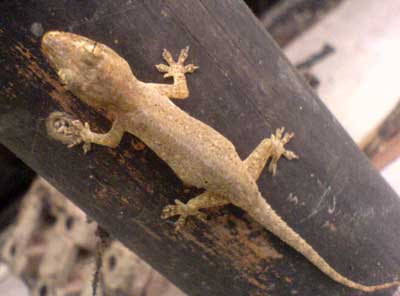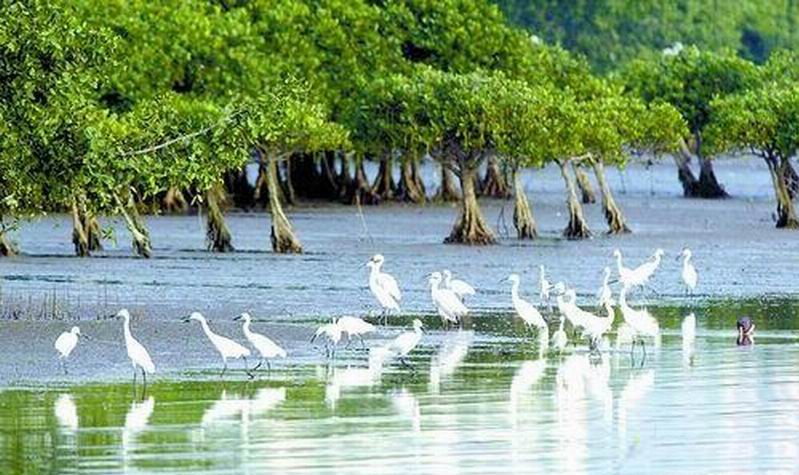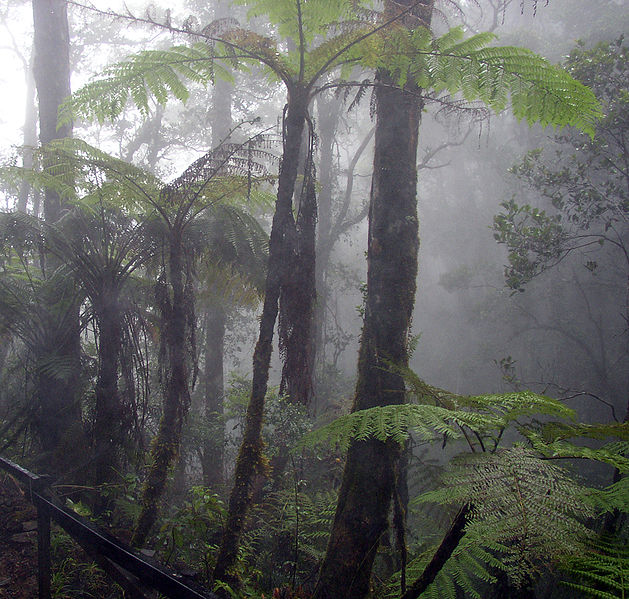I wrote this light essay originally as a column piece for the November 17, 2003 issue of Northern Dispatch Weekly. It seems timely that I re-post it here with some minor edits, now that the issue of Baguio City’s rapid deforestation is heating up anew. A giant mall has been intending to cut 182 trees in Luneta Hill, on top of big real estate developers having already cleared up a bigger number of pure pine stands in and around the city in past years.
In a column piece I wrote earlier this year, I confessed to the embarrassing fact that I was a frustrated peasant. A frustrated urban peasant, to be more specific. With emphasis on “frustrated.” At least that’s how I feel, more and more frequently these days.
My wife has more success with her orchids, ferns and peperomias — and to think that she merely used our outhouse-type toilet-bathroom as a rudimentary greenhouse. Without intending it, she turned it into an accidental orchidarium-terrarium, complete with ants, spiders, and lizards that spice up our every visit to the toilet. The only creature lacking is a fruit bat, gecko or baby constrictor crawling along the rough-hewn coconut lumber beams of the outhouse, to give our jungle alcove that extra oomph.

No, I won’t say a single word about my utter failure with strawberries, potatoes, celeries, and other denizens of the Benguet vegetable industry. Today I will confess about my feeble attempts in the forestry department.
A couple of years ago, I had bought one Araucaria and two pine seedlings at a Panagbenga garden sale (despite the outrageous prices), and carefully nursed them after replanting in our backyard. Within six months, the pine seedlings promptly died without my permission, and with nary a whimper.
The Araucaria seedling survived for almost two years, growing at least one foot high. Then one day it simply disappeared. No wilted leaves, no uprooted stem, no sign of trampling—it just plain vanished. (Maybe a neighborhood toughie thought it made for an excellent toothbrush or backscratcher, I don’t know.)
I also planted five Areca nuts from seed. Four of them absolutely refused to wake up. One finally sprouted a taproot. Then, before I could say “Hooray!” typhoon Feria tore the entire slope away.
I also planted two hefty rhizomes of a local tree fern called asibanglan. Last rainy season, two maddeningly curlicue sprouts appeared. Then one day, while I was out of the house, my aunt thought of clearing the thick weed growth in that corner of the lot. Against the coldly efficient swings of her scythe, the poor struggling asibanglan didn’t stand a chance.
Then, this summer I got some 20 pine seedlings from Cordillera environmentalist and fellow writer Mike Bengwayan, through his PINETREE project. They were good robust seedlings, and I started transferring some into bigger plastic soil bags while I prepared the slope where they would later be finally replanted. Then typhoon Chedeng boogied into town while I was out elsewhere. The bags turned topsy-turvy and I had to replace much soil. Most of the seedlings initially survived, but later became victims to other calamities.
I also had a two-year-old bamboo rhizome planting, itself retrieved from the flotsam of typhoon Feria which were deposited beside the neighborhood creek. Recently, it had sprouted several two-meter-high culms. I was jubilant. The private bamboo grove I’d long been dreaming of was on its way to reality. Then, thanks to typhoon Egay, the swollen creek tore it down and swallowed it up again.
I’ll keep mum likewise about all those failed bonsai attempts, lest my old Garden Club mentor Serapion Metilla read this piece and drop me off his reunion list.
###
“The problem with you, sir,” Kabsat Kandu lectures, “is that you keep on collecting all these books about plants but you don’t read them or follow their advice. Or maybe you’re collecting the wrong books. Your plants don’t grow, just your book collection.”
“But I do read them,” I protest. “In fact, right now I’m into this interesting book on Philippine plants, with a chapter about the different types of Philippine forests and grasslands. You know, I didn’t realize we had so many ecosystems. And I’m beginning to suspect that our neighborhood’s original ecosystem is that of a mossy cloud forest. Maybe that’s the reason why I can’t seem to grow anything here except moss and ferns.”
“Maybe that’s true, but only for your backyard. Look, even your sayote and kamote patches look sickly,” notes my irksomely observant neighbor.
“Listen to this,” I say to him, ignoring his snide remark and launching my own lecture on the subject.
According to the book Plants of the Philippines published by the UP Science Education Center, there were originally two basic forest formations in the country: lowland rain forest and lower montane forest. There was no evidence of extensive grasslands and bush country, which later emerged because of forest clearing by human settlers.
The lowland type of rainforest ranged from sea level and the humid lowlands, all the way up to 1,000-meter elevations—about the level of Mataragan in Malibcong, Abra, or Bontoc ili in Bontoc, Mountain Province, or Camp 6 in Tuba, Benguet.
###
Interestingly, there is not just one but several types of lowland forest in the country. Each one has its own distinct assemblage of trees and plants—its own distinct personality, so to speak. Let’s look at them one by one:
Lowland dipterocarp forest. — This type of forest once covered much of the country’s lowlands and foothills, and sizeable areas can still be found on the Sierra Madre and on the Cordillera foothills. It is dominated by dipterocarp tree species, the wood of which is popularly known as Philippine mahogany.
This forest has three tree layers over shrub and ground cover. The uppermost trees form a very tall canopy reaching 30-40 meters high. These are the stately hardwood timber stands of bagtikan, white and red lauan, apitong, tangile, guijo, yakal-gisok, and yakal. The middle-layer trees, such as balobo, anonang, kamagong, and katmon reach 18-20 meters high. Among the lowermost trees, 6-10 meters high, are many kinds of fruit trees.
From the trees hang vines, figs, rattans, and perching plants—including many orchids and ferns. Below the trees are the shrub layer (below six meters) and the ground layer of ferns, herbs and mosses.
Seasonal or monsoon-type forest. —This type of forest once grew extensively in the western parts of the country that had marked wet and dry seasons, such as Ilocos-Pangasinan, and in poor limestone soils. The dominant trees found here are molave or mulawin (hence the alternate name, molave forest), narra, tindalo, and banuyo.
Most of this forest has since turned into furniture and street names, and I’m only half-joking. But if you’ve ever been to the Parks and Wildlife sanctuary near the Quezon Memorial Circle in Quezon City, or the Casamata Hill in Bangued, Abra, then you have some idea of what a molave forest looks like.
Mixed swamp forest. — This kind of forest once thrived on wet alluvial plains that have long since been turned into ricefields. One can imagine that such forests must have thrived on the wide flooded river banks of Cagayan Valley and Pangasinan. Based on remnant fringes, Filipino ecologists say the tree assemblages must have been dominated by 40-meter-high Barringtonia trees such as butong and putat.
Beach forest. — Also called tropical seashore forest or strand forest, this type consists of salt-spray tolerant trees (e.g. Palomaria, butong, agoho, balete, dapdap, kalumpang, talisay, and dungong-late) growing in fringes along the seashore. Below and around the tree groves grow Pandanus (screw pines), maritime shrubs, herbs, small vines, grasses, and sedges.
Mangrove swamp forests. — As the name implies, the dominant trees are mangrove species such as bakawan and tangal, which thrive in brackish water and tidal mudflats along river mouths, estuaries and lagoons. You could get hopelessly lost or trapped on a boat navigating through the tangle of an extensive mangrove forest.

####
Starting at around 1,000-meter elevations, the mountain climate turns cooler and more temperate. This is what geographers call the mid-mountain region, which in the Philippines goes all the way up to the 2,700-meter elevation, or a few hundred meters lower than the summits of Mount Apo and Mount Pulog.
Here may still be found extensive tracts of what ecologists call the lower montane or mid-mountain forest. (We don’t have higher montane forests, which are found at elevations of 3,000 meters and higher, like in the highlands of Borneo and New Guinea.)
Compared to the lowland forest, the lower montane forest has lower and less dense growth, and at most only two tree layers: a canopy layer at heights of 25-30 meters, and a subcanopy layer at about 16 meters. The bulk of the Cordillera highlands and the higher ridges of the Sierra Madre and Caraballo belong to this category of forest.
The forest typology becomes more interesting here, because the dipterocarps lose their dominance and are replaced by other tree assemblages.
Oak-laurel forest. — This is the most extensive type. The dominant types of trees here are the laurels, such as Neolitsea, Ginnamomum (e.g. kalingag), and Litsea (e.g. sablot, batikuling, warang), and the oaks or Quercus. Curiously, I haven’t seen any specific Quercus entries in my long list of Philippine trees, although I know that native oaks called palayen or palayon are very common in the Cordillera uplands. In such forests are various types of tree ferns (my poor asibanglans!), hanging ferns, and ground ferns.
Pine forest. — “You don’t have to explain that to me, I know all about pine forests. Don’t forget, I grew up in one!” Kabsat Kandu smugly says.
“Is that so? Well, listen to this,” I continue.
Millions of years ago, paleontologists say, the country’s climates were cooler, and our islands were not yet islands but connected to mainland Asia to the northwest. In those millions of years, the pines and other temperate species would have spread from there to here. When our climate warmed, the pine forests receded to where they are now: in the drier, cool mid-mountain levels of the Cordillera and Mindoro. Meanwhile, the lower montane forests thrived at the lower levels—e.g. along the ravines and water courses—and on the moister eastern slopes of big massifs such as Mount Polis and Mount Data.
Lower montane mist forest
“Now we get to the most interesting part,” I note. “Here’s where I discover what our community must have looked like, before it was cleared by humans.”
“You must mean your backyard,” Kabsat Kandu deadpans. I don’t mind, and go on.

At elevations higher than 2,500 meters, such as the upper slopes of Mount Pulog, persistent daily mists descend on the landscape. Here, the open, sunny pine forests abruptly give way to a dim, dense, wet, mossy broadleaf forest. A single tree layer forms a low canopy of 6-8 meters. Because of the much-reduced sunlight, trees are stunted and gnarled, and a dense growth of moss and liverwort cover tree branches, trunks, down to the rocks and forest floor. Thus, it’s also called the mossy forest or cloud forest.
“But that’s much higher than our elevation, which is just around 1,500 meters! I don’t see any cloud forest around.” You have got to give it to Kabsat Kandu—he has these exotic flashes of insight.
Anyway, I explain to him that, often, micro-climates on leeward sides and deep-shaded slopes of mountains allow such montane mist forest to grow at lower elevations. “That, for example, is the case with portions of Mount Makiling, which is much lower than us. I tell you, we’re located in a former cloud forest that’s been cleared. That’s why Baguio people call this place balay ti liboo. That’s the reason why my seedlings barely survive.”
“I still think that cloud cuckoo land is located only in your yard, or inside your head,” Kabsat Kandu says.
Of course I don’t believe my own explanation. It is just a convenient, self-serving excuse for my bumbling efforts at reforestation.
###
There is one final question: Paleo-botanists are agreed that originally there were no true grassland ecosystems in the Philippines, such as those found in the African savanna and Asian steppe. Why do wide grasslands now occupy formerly vast forests in our country?
The typical answer: Well, because human communities cleared the forests for agriculture.
But the question remains: There are now so many areas abandoned to kogon or pan-aw (Imperata cylindrica) and talahib or lidda (Saccharum spontaneum), which have not been farmed for decades after they were first cleared. But forest regrowth has not returned. Why?
Above all, we must remember that many tropical and subtropical grasses, especially pan-aw and lidda, are fire-resistant. Even if you repeatedly scorch an entire grassy slope, the roots will survive and sprout again after the next rains, and grow more luxuriant than ever.
After a patch of forest is cleared for shifting cultivation (kaingin, uma) and then abandoned, forest regrowth will start anew. But if the kaingin cycle is repeated many times over the same area, as in intensive rotating fallow farming, the succeeding periods produce more and more scrubby regrowth that’s easier to set afire—either intentionally by farmers and cattle ranchers, unintentionally by careless passersby, or naturally during thunderstorms. The fire-resistant grasses (e.g. pan-aw and lidda) and scrub begin to dominate, and forest regrowth becomes more and more difficult.
In many areas of steep slope, this process gradually impairs water retention and worsens soil erosion and leaching. A vicious cycle is started, in which grass growth promotes seasonal fires, which creates poor soil conditions, and which in turn increases grass growth. Token reforestation of such slopes, in which thousands of seedlings are planted en masse then left to survive on their own without exacting care—except maybe in press releases and photo ops—is just an awful waste of money.
Ecologists say it’s not too difficult to break this vicious cycle if serious community cooperation is ensured. They say that, in some cases, only two straight years of absolute fire prevention are needed for shrub-vine combinations to start growing over the tall grasses. The taller shrub-vine canopy gradually replaces the tall grasses. In three more fire-less years, they say, the shrub-vine community would be gradually replaced by secondary forest species dominated by softwoods like acacias, langka, balete, etc. The area is then expected to gradually revert back to climax forest.
###
It would really be nice if each community (whether rural or urban) could sustain its own mini-forest—if only for residents, research students, and tourist visitors to have an idea of what it felt like a century or several centuries ago. But there are bigger social factors, like rural landlessness, urban congestion, and the intense pressures of the market economy, that prevent this from happening that easily.
To restore ecological balance over a broad territory requires much more than just enjoining every schoolchild to plant a tree, and every community to maintain a mini-forest. It requires a drastic revision of the social economy and people’s lifestyles as a whole. To be really frank, it requires changing the system via a thoroughgoing social revolution.
Meanwhile, however, I haven’t given up the dream of growing my own private micro-forest. Mossy and misty it might be nearly every day, but my backyard will yet grow pine and bamboo, as well as cloud-resistant varieties of mango, guava, citrus, banana, and maybe even coconut.
That is, if the demolition team and the realtor’s bulldozers don’t get here first. #
Follow @junverzola

